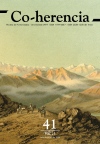El impacto de la cuarta dimensión lírica en la poesía satírica de Ambrose Bierce: un análisis del recurso expresivo fonológico en dos de sus poemas
Main Article Content
Keywords
Ambrose Bierce, dimensión fonológica, lírica, multidimensionalidad poética, poesía satírica, Shapes of Clay, voz
Resumen
El presente trabajo pretende demostrar que el componente fonológico de la poesía de Ambrose Bierce constituye un recurso expresivo mediante el cual el escritor satírico transmite de una manera más eficaz la crítica social que vertebra sus composiciones. El tratamiento particular de dicho componente, junto con un tono satírico e irónico, se combina en el objeto poético para señalar de una manera más incisiva la denuncia que hace Bierce de distintos miembros de la sociedad estadounidense de fin de siècle. En concreto, este análisis se centra en “Arma Virumque” y “King of Bores”, poemas pertenecientes a su colección Shapes of Clay, en los que el poeta ridiculiza la institución militar de ee. uu. y la figura del “pelma”, respectivamente. Este estudio sigue las ideas postuladas por Abrams (2012) sobre la “cuarta dimensión” del poema o, en otras palabras, los significados que los rasgos fonológicos de una composición lírica dejan entrever a partir de su recitación. Los resultados de este trabajo indican que este recurso le permite al lector experimentar en su propio cuerpo, mediante su aparato fonador, la cáustica crítica social que Bierce plasma en sus poemas.
Descargas
Referencias
Adrjan, P., & Muñoz-Basols, J. (2003). The Sound of Humor: Linguistic and Semantic Constraints in the Translation of Phonological Jokes. SKY Journal of Linguistics, 16, 239-246. https://n9.cl/jxaff.
Aryani, A., Kraxenberger, M., Ullrich, S., Jacobs, A. M., & Conrad, M. (2016). Measuring the basic affective tone of poems via phonological saliency and iconicity. Psychology of Aesthetics, Creativity, and the Arts, 10(2), 191-204. https://doi.org/10.1037/aca0000033.
Berkove, L. (2002). A Prescription for Adversity. The Moral Art of Ambrose Bierce. Ohio State University Press.
Bierce, A. (1903). Shapes of Clay. W. E. Wood Publisher.
Bierce, A. (1911). To Train a Writer. En A. Bierce (Ed.), The Collected Works: The Opinionator (pp. 75-79). Neale Publishing.
Bierce, A. (1922). The Letters. En B. Clark (Ed.), The Letters of Ambrose Bierce (pp. 33-245). The California Book Club.
Bierce, A. (1980). The Seamy Side of It. En L. Berkove (Ed.), Skepticism and Dissent. Selected Journalism from 1898-1901 (pp. 7-11). Delmas.
Bierce, A. (2011). Cuentos negros (A. Ibarrola, Trad.). Alianza.
Bierce, A. (2016). Cuentos inquietantes (A. Ibarrola, Trad.). Alianza.
Bierce, A. (2019). El diccionario del diablo (V. Campos, Trad.). Sexto Piso.
Bierce, A. (2021). Poemas de barro (A. García, Trad.). Verbum.
Clark, B. (1922). Introduction. En B. Clark (Ed.), The Letters of Ambrose Bierce (pp. 6-23). The California Book Club.
Fatout, P. (1951). Ambrose Bierce. The Devil’s Lexicographer. University of Oklahoma Press.
Ferlinghetti, L., & N. Peters. (1980). Literary San Francisco. A Pictorial History from its Beginnings to the Present Day. City Lights Books.
Grattan, C. H. (1929). Bitter Bierce: A Mystery of American Letters. Doubleday, Doran & Company.
Grenander, M. (1996). Introduction. En M. Grenander (Ed.), Poems of Ambrose Bierce (pp. 13-43). University of Nebraska Press.
Hart, J. (1931). In Our Second Century from an Editor’s Note-Book. The Pioneer Press.
Ibarrola, A. (2011). Unas palabras acerca de los Cuentos negros de Ambrose Bierce. En A. Ibarrola (Ed.), Cuentos negros (pp. 131-143). Alianza.
Joshi, S. T. (2013). A Triumvirate of Fantastic Poets: Ambrose Bierce, George Sterling, and Clark Ashton Smith. Extrapolation, 54(2), 147-161. https://doi.org/10.3828/extr.2013.9.
Klarer, M. (2004). An Introduction to Literary Studies (2.a ed.). Routledge.
Kristeva, J. (1974). Phonetics, Phonology and Impulsional Bases. Diacritics, 4(3), 33-37. https://doi.org/10.2307/465110.
Lehan, R. (2005). Realism and Naturalism. The Novel in an Age of Transition. University of Wisconsin Press.
Linneman, W. R. (1962). Satires of American Realism, 1880-1900. American Literature, 34(1), 80-93. https://doi.org/10.2307/2922247.
Lord, J. B. (1975). Syntax and Phonology in Poetic Style. Style, 9(1), 1-31. http://www.jstor.org/stable/45108346.
McWilliams, C. (1929). Ambrose Bierce. A Biography. Albert & Charles Boni.
Merriam-Webster Dictionary. (2024). Fiddlefaddle. https://n9.cl/3ztp5.
Minnick, L. C. (2004). Dialect and Dichotomy. Literary Representations of African American Speech. University of Alabama Press.
Morris, R. (1998). Ambrose Bierce. Alone in Bad Company. Oxford University Press.
Newcomb, J. T. (2004). Would Poetry Disappear? American Verse and the Crisis of Modernity. Ohio State University Press.
Osterbrock, C. (2021). Augusto/Hopkins. Translation and the Fourth Dimension of a Poem. Santa Barbara Portuguese Studies, 8, 121-135. https://n9.cl/iufk3z.
Parrish, A. (2017). Poetic Sound Similarity Vectors Using Phonetic Features. Proceedings of the AAAI Conference on Artificial Intelligence and Interactive Digital Entertainment, 13(2), 99-106. https://doi.org/10.1609/aiide.v13i2.12971.
Sidney-Fryer, D. (1980). Introduction. En D. Sidney-Fryer (Ed.), A Vision of Doom. Poems by Ambrose Bierce (pp. 9-29). M. Grant Publisher.
Sidney-Fryer, D. (2011). The Golden State Phantasticks. The California Romantics and Related Subjects. Hippocampus Press.
Sterling, G. (1922). A Memoir of Ambrose Bierce. En B. Clark (Ed.), The Letters of Ambrose Bierce (pp. 23-32). The California Book Club.
Sterling, G. (1925, septiembre). The Shadow Maker. American Mercury, (6), 10-19.
Ufot, B.G. (2013). Phonology and Stylistics: A Phonaesthetic Study of Gray’s ‘Elegy Written in a Country Churchyard’. English Linguistics Research, 2(2), 110-125. https://doi.org/10.5430/elr.v2n2p110.
Zink, S. (1945). The Poetic Organism. The Journal of Philosophy, 42(16), 421-433. https://doi.org/10.2307/2019658.





